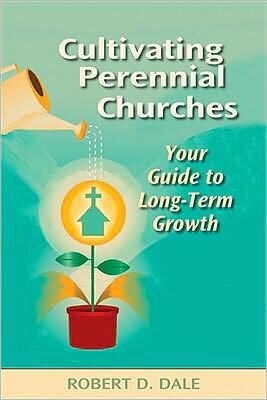Robert D. Dale, Cultivating Perennial Churches: Your Guide to Long-Term Growth (TCP Leadership Series). Chalice Press, 2008.
Referenced in:
- Church Leadership Strategies, Traditional Church Renewal
- Research and Case Studies on Effective Churches
LifeandLeadership.com Summary
Bob Dale has written extensively on congregational leadership. Here he addresses his passion for long-term growth and vitality. Few churches achieve this, so he set out to study a few that have grown and stayed vital for 25-30 years or more. He calls these churches “perennial,” like the difference between perennial and annual plants. Annual plants have a lifespan of a single growing season, but perennials live on and on.
In his study, he profiles seven churches that share the following three characteristics:
- 25-30 year or longer growth arcs showing durability, creativity, vitality, and creativity
- Grow, adapt, and multiply their ministries steadily. They are both productive and reproductive.
- Live and thrive over time, cultivating their core identity without fads and in less than perfect conditions.
In addition, he describes seven major characteristics of perennials:
- Perennials reflect their planters purpose, focused on kingdom expansion.
- Perennials grow stronger root systems, anchoring healthy DNA or identity that repeatedly produces fruitful ministry over time.
- Perennials are resilient and tough, emerging from challenges and difficulties with new vitality and steadiness.
- Perennials thrive in “mixed meadows,” thriving in a diverse and often confusing mission environments.
- Perennial grow from a variety of beginnings, and maintain flexibility around a solid, central core of belief.
- Perennials grow during all seasons, with the capacity to make adjustments as their missional contexts change.
- Perennials reproduce with the future in mind, engaging exciting futures that respect and build upon their pasts.
The seven churches profiled show most of the distinctive qualities of perennials, but Dale matches each of the characteristics with one church as a sort of case study of growth and health over time. Each case study spotlights a specific issue and explores the living historical context encountered by the church regarding this issue. What emerges are pictures of churches that have been faithful to God season after season. Some of these are “old churches that have become young again, churches that nearly die and then rise from the dead, churches that creatively interact with their communities and the world, and churches that produce change in their ministry settings and beyond.” (15)
The final chapter discusses master principles of leadership as observed among the leaders of these perennial churches:
- Leaders stand on deep theological foundations and the central designs of God.
- Leaders understand, respect, and extend congregational DNA.
- Leaders remain steadfast, patient, and never give up.
- Leaders value and enrich diversity.
- Leaders bridge differences by committing to larger truth.
- Leaders focus production and reproduction
- Leaders cultivate future intention from identity.
This is an excellent descriptive look at churches with staying power. It is not intended as a step-by-step renewal process, but any church wanting to base renewal efforts on principles that promise long-term kingdom return will want to read this book. It is well-written with reflective “coaching questions” interspersed throughout.
This book is part of The Columbia Partnership Leadership Series. The TCP Leadership Series is an inspiration- and wisdom-sharing vehicle of The Columbia Partnership, a community of Christian leaders seeking to transform the capacity of the North American Protestant church to pursue and sustain vital Christ-centered ministry.
From the Publisher
There are many books for churches looking to start with a healthy beginning. But what happens after the big boom of a church’s start? Today, roughly eight of ten American congregations are either static or in decline. Many of those churches started out with an outstanding start. But why didn’t they succeed in the long run?
This book is about church growth and health from a different angle—long-term growth and vitality. Author Bob Dale writes from his more than 30 years of experience to show not just how to plant a church, but how to keep it healthy and always growing.
About the Author
Bob Dale has thirty years of experience as a church leader development specialist. He has authored more than twenty books, including Seeds for the Future (Chalice Press).
***For additional information on this resource, including reviews, click the bookstore links. Check the reference at page top or the links below for resource guides on related topics.***
Related Areas
See Other Resources on Church Leadership and Renewal:
- Church Leadership and Renewal, Index
- Church Leadership, Theological Foundations, Ecclesiology
- Church Leadership, Philosophical Foundations – e.g. Church Growth, Missional, Emergent, and Other Missionally Responsive Trajectories
- Church Leadership, Practical Foundations – Church Dynamics and Research
- Church Leadership, Practical Foundations – Congregational Culture, Church Identity
- Church Leadership, Practical Foundations – Size Dynamics, Size Transitions
- Church Leadership, Practical Foundations – Research and Case Studies on Effective Churches
- Church Leadership, Special Situations – Small Church Development
- Church Leadership, Strategies for Renewal
See Resources on Over 100 Areas of Ministry Leadership:


